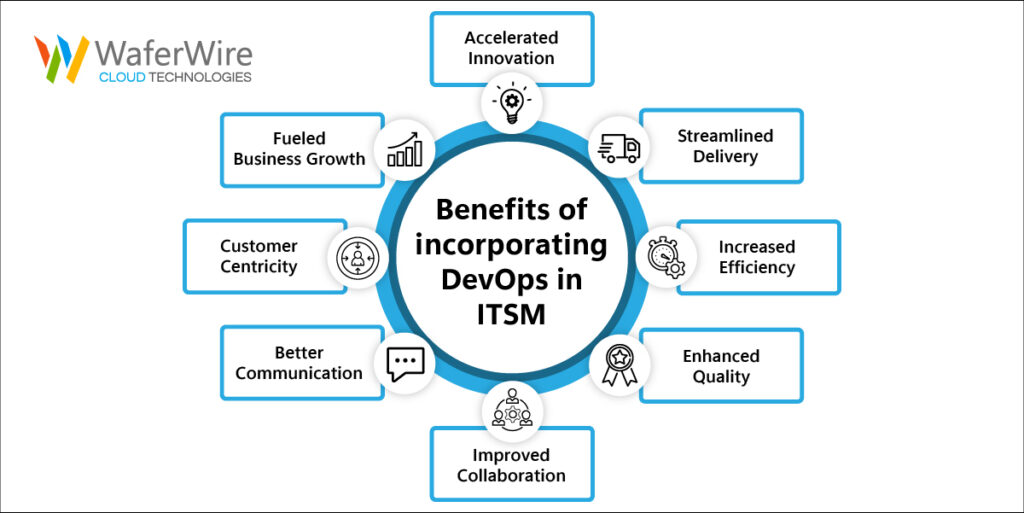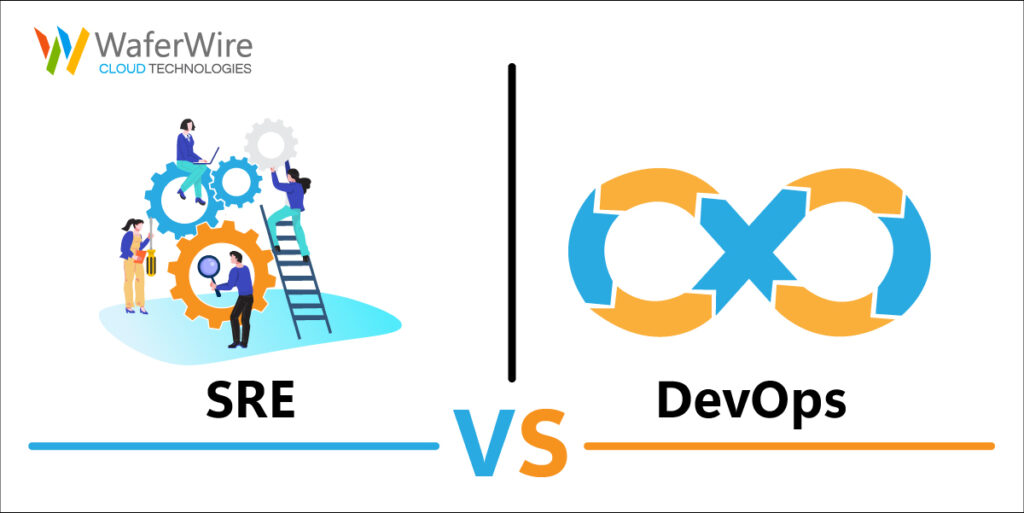

In IT Service Management (ITSM) world, organizations face daunting hurdles. Resistance to change, siloed operations, legacy systems, and lack of standardization test their resilience. But the quest for efficiency requires conquering these challenges through collaboration, modernization, and standardized processes. Enters DevOps- a game-changing component of modern ITSM. Picture this- Development and operations teams that were once isolated in their own corners have now united under the DevOps banner. They join forces, collaborating seamlessly to drive innovation and deliver exceptional results. Gone are the days of lengthy development cycles and cumbersome handoffs. DevOps brings a new rhythm to ITSM, powered by continuous integration and delivery. Software updates flow effortlessly from development to deployment, enabling organizations to respond swiftly to customer demands. But there's more to the DevOps story. Automation takes center stage, liberating teams from mundane tasks and unleashing their potential. Repetitive processes are streamlined, freeing up valuable time for creativity and problem-solving. Efficiency soars as manual interventions dwindle, paving the way for greater productivity and seamless operations. What truly sets DevOps apart is its emphasis on collaboration. Development and operations teams become partners in crime, working hand in hand towards a shared goal. Communication flows effortlessly, knowledge is shared, and solutions are forged collaboratively. This unity fosters a culture of innovation, where ideas thrive, and problems are solved faster than ever before.

Concisely, incorporating DevOps in ITSM brings numerous benefits like-
While DevOps offers numerous benefits for IT Service Management (ITSM), it's crucial to understand the distinct role of Site Reliability Engineering (SRE). This helps organizations to leverage them effectively in tandem, achieving comprehensive software development and maintaining reliable systems. Let's dive into the details.

Site Reliability Engineering (SRE) is a methodology that originated at Google to manage the reliability of large-scale, distributed systems. SRE is like DevOps in emphasizing collaboration and automation. However, SRE focuses specifically on the reliability of systems, whereas DevOps is a broader methodology encompassing the entire software development lifecycle. SRE involves a set of practices that aim to ensure the reliability and availability of systems. It achieves this by focusing on monitoring, alerting, capacity planning, and incident response. SRE also emphasizes automation, enabling organizations to automate repetitive tasks and reduce the likelihood of errors. While both DevOps and SRE aim to improve the efficiency of IT service delivery, they have different focuses. DevOps aims to improve the entire software development lifecycle, whereas SRE focuses only on system reliability.
Let's eliminate bottlenecks, optimize efficiency, and drive business growth together!
To optimize efficiency and drive business growth, it's crucial to leverage the right ITSM and DevOps tools that promote collaboration and automation. By integrating these tools, organizations can achieve faster delivery and improved product quality.
ITSM and DevOps both require specialized tools to manage their respective processes. ITSM tools include IT service management software, IT asset management software, and ITIL (Information Technology Infrastructure Library) frameworks. On the other hand, DevOps tools include CI/CD, containerization, orchestration, monitoring, and logging tools. ITSM and DevOps tools together ensure efficient IT service management. By integrating ITSM and DevOps tools, organizations can achieve greater collaboration and automation, leading to faster delivery times and improved product quality.
Azure DevOps is a set of DevOps services offered by Microsoft that enable organizations to build, test, and deploy software more efficiently. Azure DevOps includes several tools, including Azure Boards, Azure Repos, Azure Artifacts, and Azure Test Plans. Azure Boards is a project management tool that enables organizations to plan and track work across teams. Azure Repos is a code repository that allows organizations to store and manage code securely. Azure Artifacts is a package management tool that enables organizations to store and share packages and dependencies. Azure Test Plans allow organizations to test and validate software more efficiently. Azure DevOps plays a crucial role in ITSM by enabling organizations to deliver products and services faster and with higher quality. By providing a range of tools for project management, code management, package management, and testing, Azure DevOps enables organizations to manage their IT services more efficiently.
SRE impacted DevOps in system reliability. Using practices like monitoring, alerting, capacity planning, and incident response, SRE ensures large-scale, distributed systems are reliable. Google SRE has also emphasized the importance of automation in achieving system reliability. It is easy to ensure your systems are reliable and available by automating repetitive tasks. The principles of Google SRE have been adopted by many organizations, particularly those with large-scale, distributed systems. By incorporating the practices of Google SRE into DevOps, organizations can achieve better system reliability and availability.
Implementing DevOps in ITSM can be challenging, particularly for organizations with traditional ITSM practices. However, there are a few best practices and strategies you can use to implement DevOps successfully. Firstly, organizations should focus on creating a culture of collaboration and continuous improvement. This involves breaking down the silos between development and operations teams and creating a culture of open communication and feedback. Secondly, organizations should emphasize automation. By automating repetitive tasks, organizations can free up time for more strategic tasks, leading to greater efficiency and productivity. Thirdly, organizations should adopt a continuous integration, testing, and deployment (CI/CD) approach. This involves automating the entire software development lifecycle, from code management to testing to deployment. Lastly, organizations should measure the success of their DevOps implementation using metrics such as deployment frequency, lead time, and mean time to recovery. These metrics can help organizations identify areas for improvement and track their progress over time.
Ready to unlock the full potential of DevOps in your ITSM practices?
In ITSM, DevOps can be challenging, especially for organizations with traditional ITSM practices. There are some challenges that organizations may face. They include resistance to change, lack of collaboration and communication, and difficulty in legacy system automation. Resistance to change can be a significant challenge for organizations looking for DevOps adoption. The ITSM practices in many organizations are deeply ingrained, so convincing stakeholders to change can be difficult. Lack of collaboration and communication between development and operations teams can also be a significant challenge. DevOps requires a culture of collaboration and open communication, and it can be tough to achieve this in organizations with siloed teams. Finally, automating legacy systems can be a significant challenge for organizations looking to adopt DevOps. Complex legacy systems are hard to automate, so DevOps adoption can be slow.
Measuring the success of DevOps in ITSM is essential to identify areas for improvement and track progress over time. There are several metrics that organizations can use to measure the success of their DevOps implementation. Deployment frequency is a critical metric that measures how frequently organizations deploy software. A high deployment frequency indicates that organizations deliver software faster, whereas a low deployment frequency shows bottlenecks in the software development lifecycle. Lead time is another essential metric measuring the time it takes to move from code commit to production. A low lead time indicates that organizations deliver software faster, whereas a high lead time shows bottlenecks in the software development lifecycle. Mean time to recovery (MTTR) is a metric that measures how long it takes to recover from a system outage. A low MTTR indicates that organizations are responding quickly to system outages, whereas a high MTTR shows issues with incident response.
DevOps is more than just a methodology; it is a culture. Building a DevOps culture in ITSM requires a significant shift in mindset and practices. It involves breaking down silos and creating a culture of collaboration, continuous improvement, and automation. To build a DevOps culture, organizations should focus on creating an environment of continuous learning and experimentation. This involves encouraging teams to experiment with innovative technologies and practices and providing them with the resources they need to do so. Additionally, organizations should focus on creating a culture of ownership and accountability. This involves empowering teams to take ownership of their work and be accountable for their results. Finally, organizations should focus on creating a culture of automation. This involves automating as many tasks as possible to free time for more strategic tasks.
DevOps has become an essential component of modern ITSM, enabling organizations to deliver products and services faster and with higher quality. As organizations continue to adopt DevOps, it is likely that we will see more integration between ITSM and DevOps tools and practices. The future of DevOps in ITSM is bright, and we can expect to see more organizations embracing a culture of collaboration, continuous improvement, and automation. By adopting DevOps, organizations can achieve greater efficiency, productivity, and customer satisfaction, enabling them to stay competitive in an ever-changing market. As you can see, DevOps plays a crucial role in IT service management. Implementing DevOps in ITSM can be challenging, but the benefits are significant. If you want to adopt DevOps, consider the best practices and strategies outlined in this article. So, start achieving greater efficiency, productivity, and customer satisfaction today!
